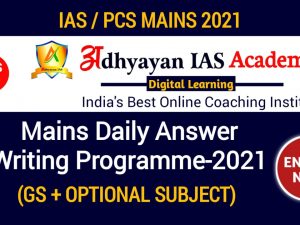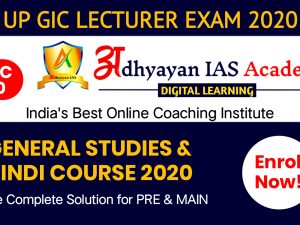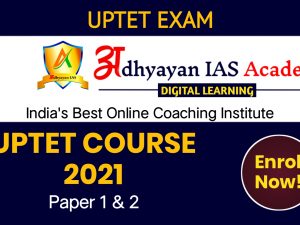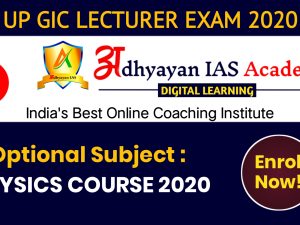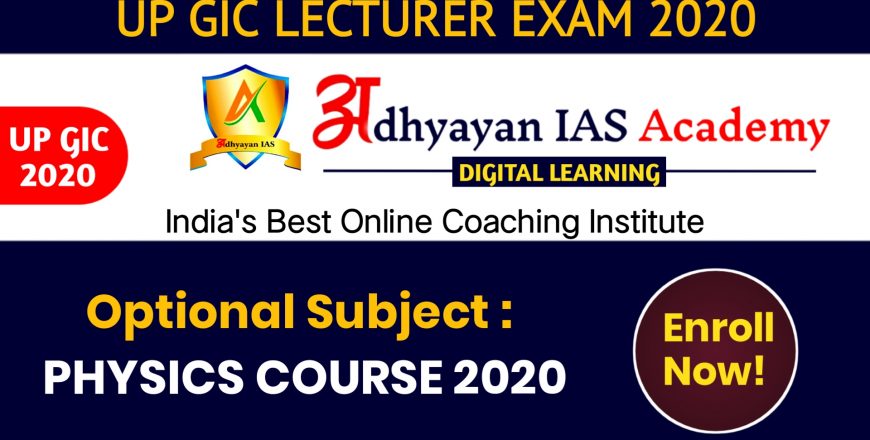
- Description
- Curriculum
- Reviews
About Exam
Uttar Pradesh Public Service Commission will soon conduct the Written Exam for the Posts of Lecturer. Candidates who applied for these Posts are now waiting for the Exam Dates. Many candidates are Searching and Enquiring about the Exam Dates from Various Sources. Though, the Exam Dates are not released yet, but soon it will be release on the Official website of UPPSC.
Nowadays Competition Level become very high so Competitive Exams gets too tougher. Candidates facing critical problem of “What to prepare” and “How to prepare” to give their best in their exams. So, here we are providing the latest Syllabus & Exam Pattern.
Selection Process
Pre exam
Mains Exam
Exam Pattern
Exam Pattern for the Written Exam is as Follows:
प्रारम्भिक परीक्षा में सामान्य अध्ययन/वैकल्पिक विषय का एक प्रश्नपत्र होगा जो वस्तुनिष्ठ व बहुविकल्पी प्रकार का होगा।
इसमें प्रश्नों की संख्या 120 (वैकल्पिक विषय के 80 प्रश्न तथा सामान्य अध्ययन के 40 प्रश्न) होगा जो कुल 300 अंकों का होगा।
समय 2 घण्टे का होगा।
गलत उत्तर देने पर 1/3 का ऋणत्मक अंकन किया जायेगा।
Exam Syllabus
Exam Syllabus for Examination is given below
PART -I
(A) General Studies
1.General Science (High School Standard)
2.History of India
3.Indian National Movement
4.Indian Polity, Economy & Culture
5.Indian Agriculture, Commerce & Trade
6.World Geography & Indian Geography & Natural resources of India
7.Current National and International Important events
8.Logic & Reasoning based on General Intelligence.
9.Specific knowledge regarding Education, Culture, Agriculture, Industry Trade, Living & Social Traditions of Uttar Pradesh.
10.Elementary Mathematics up to 8th level: Arithmetic, Algebra and Geometry.
11.Ecology and Environment.
PART -II (PHYSICS)
I Mathematical physics
(A)Vector
scalar and vector products, vector identities, background of vector calculus, concept of line, surface and volume integrals, physical meaning of gradient, divergence and curl, Gauss and Stake’s theorems.
II. Mechanics
(A)Rotational mechanics
Centre of mass, rotating frame of reference, Coriolis force, motion of rigid bodies, moment of inertia, theorem of parallel and perpendicular axes, movement of inertia of sphere, ring, cylinder and disc. Angular momentum, Torque
(B)Gravitation
central force, Kepler’s Law, motion of satellite (including geostationary satellite)
(C) Theory of relativity
Galileo transformation, special theory of relativity, Michelson – Morley experiment, Lorentz transformation equations, variation of mass and length with velocity, time dilation, addition of velocities and mass-energy equivalence relation.
(D) Fluid Mechanics
Stream line and turbulent motions, Reynold’s number, Stake’s law, Poiseuille’s formula, flow of liquid through narrow tube. Bernoulli’s formula with applications, surface tension.
(E) Bulk properties of Matter (Elasticity)
Stress- strain relationship, Hooke’s Law, moduli of elasticity and interrelation between them Poisson’s ratio, elastic energy.
III. THERMAL PHYSICS
(A) Thermodynamics
Concept of temperature and the zeroth law, first law of thermodynamics and internal energy, isothermal and adiabatic changes, second law of thermodynamics, Entropy, Carnot cycle and Carnot engine, absolute scale of temperature. Maxwell’s thermodynamically relations. The Clausius- Chaperon equation, pours plug experiment and Joule Thomson effect.
(B)Kinetic theory of gases
Maxwell distribution law of velocities, calculation of mean velocity, root mean square velocity and the Most probable velocity, degrees of freedom, Law of equipartition of energy, specific heats of gases, mean free path, transport phenomena.
(C)Radiation
Stefan’s law, Newtons law of cooling Wien’s law, Rayleigh Jeans law, Planck’s law, solar constant.
(D)Cooling of Gases
Production of low temperatures by adiabatic demagnetization.
IV. WAVES AND OSCILLATIONS
(A)Oscillation simple harmonic motion, stationary and progressive waves, damped harmonic motion, forced oscillations and resonance, sharpness of resonance, wave equation, Plane and spherical waves superposition of waves. Fourier analysis of periodic waves- square and triangular waves, phase and group velocities, Beats.
V. OPTICS
(A) Geometrical Optics
Cardinal points of a coaxial system, simple problems on combination of thin lenses eyepiece- Ramsden and Huygens eyepieces.
(B) Physical Optics
Huygens’s principle, conditions for sustained interference Young double slit experiment division of amplitude and wave front, Fresnel Biprism, Newtons rings, Michelson-interferometer, diffraction by straight edge, single, double and multiple slits. Rayleigh’s criterion, resolving power of optical instruments.
Polarization, production and detection of polarized light (linear circular and elliptical) Brewster’s law, Huygens’s theory of double refraction, optical rotation, polarimeters.
VI.LASER
(A) Temporal and spatial coherence, stimulated emission, basic ideas about laser emission, Ruby and He-Ne lasers.
VII . electricity and Magnetism
(A)Electrostatics
Gauss law and its applications, electric Potential
(B) Current electricity
Kirchhoff’s laws and their applications, Wheatstone’s bridge
(C) Magnetostatics and magnetic effect of electric current
Biota-Savart law, Ampere’s circuital law, and their applications. Magnetic induction and field strength, magnetic field on the axis of circular coil,
(D) Electromagnetic induction
Faraday’s and Lenz’s law, self and mutual inductances
(E) Alternating current
L.C.R. circuits, series and parallel resonance Circuits, quality factor.
(F) Electromagnetic wave
Maxwell’s equations and electromagnetic waves transverse nature of electromagnetic waves, Poynting vector.
(G) Magnetic properties of matter
diamagnetic , paramagnetic , ferromagnetic , antiferromagnetic and ferromagnetic (qualitative approach only), hysteresis.
VIII. MODEREN PHYSICS
(A) Atomic Physics
Bohr’s theory of hydrogen atom, electron spin, Pauli’s exclusion principle, optical and X-ray spectra, spatial quantization and Stern-Gerlach experiment, vector model of the atom, spectral terms, fine structure of spectral lines J-J and L-S coupling, Zeeman effect, Raman effect, photoelectric effect, Compton effect, de Broglie waves, wave-particle duality, Uncertainty principle
(B) Quantum Mechanics
postulates of quantum mechanics, Schrodinger wave equation and its applications to (i) particle in a box (ii) motion across a step potential (iii) one dimensional harmonic oscillator, and engine values.
(C) Quantum Theory of solids
Einstein’s and Debye theory of specific heat of solids.
(D)Solid State Physics
Band theory of solids energy band, Kroni-Penny model in one dimension, energy gap, distinction between metals, semiconductors and insulators, variation of Fermi level with temperature and effective mass.
(E)Nuclear Physics
alfa, beta and gamma radiations, elementary theory of alpha decay, nuclear binding energy, Semi empirical mass formula, nuclear fission and fusion
(F)Particle Physics
nuclear reactors elementary particles, particle accelerator, cyclotron, linear accelerator
(G)Statistical Physics
Elementary idea’s of super conductivity.
(IX) ELECTRONICS
(A) Solid state devices
Intrinsic and extrinsic semiconductors, PN, junction, Zener diode, and their characteristics, unipolar and bipolar transisters solar cells, use of diode and transistor for rectification, amplification, oscillation
(B)Digital Electronics
modulation and detection, waves. Logic gates and their truth tables, some applications
Mains Examination:
Exam Pattern :
Exam Pattern for the Written Exam is as Follows:
प्रथम प्रश्नपत्र
सामान्य हिन्दी एवं निबन्ध (परम्परागत)
समय- 02 घण्टा
पूर्णांक – 100 अंक
द्वितीय प्रश्नपत्र
वैकल्पिक विषय (परम्परागत)
समय- 03 घण्टा
पूर्णांक – 300 अंक
PAPER – I GENERAL HINDI
प्रथम खण्ड
सामान्य हिन्दी, निर्धारित अंक-50
अपठित गद्यांश का संक्षेपण, उससे सम्बन्धित प्रश्न, रेखांकित अंशों की व्याख्या एवं उसका उपयुक्त शीर्षक।
अनेकार्थी शब्द, विलोम शब्द, पर्यायवाची शब्द, तत्सम एवं तद्भव, क्षेत्रीय, विदेशी (शब्द भण्डार), वर्तनी, अर्थबोध, शब्द-रूप, सन्धि, समास, क्रियायें, हिन्दी वर्णमाला, विराम चिन्ह, शब्द रचना, वाक्य रचना, अर्थ, मुहावरे एवं लोकोक्तियाँ, उत्तर प्रदेश की मुख्य बोलियाँ तथा हिन्दी भाषा के प्रयोग में होने वाली अशुद्धियाँ।
द्वितीय खण्ड
हिन्दी निबन्ध, निर्धारित अंक-50
इसके अन्तर्गत एक खण्ड होगा। इस खण्ड में से एक निबन्ध लिखना होगा। इस निबन्ध की अधिकतम विस्तार सीमा 1000 शब्द होगी। निबन्ध हेतु निम्नवत् क्षेत्र होंगे:-
(A) साहित्य, संस्कृति
(B) राष्ट्रीय विकास योजनायें/क्रियान्वयन
(C) राष्ट्रीय-अन्तर्राष्ट्रीय, सामयिक सामाजिक समस्यायें/निदान
(D) विज्ञान तथा पर्यावरण
(E) प्राकृतिक आपदायें एवं उनके निवारण
(F) कृषि, उद्योग एवं व्यापार
PAPER -II PHYSICS
I. MATHEMATICAL PHYSICS
(A) Vector algebra
scalar and vector products, vector identities, background of vector calculus, concept of line, surface and volume integrals, physical meaning of gradient, divergence and curl, Gauss and Stake’s theorems.
II. Mechanics
(A) Rotational mechanics
Centre of mass, rotating frame of reference, Coriolis force, motion of rigid bodies, moment of inertia, theorem of parallel and perpendicular axes, movement of inertia of sphere, ring, cylinder and disc. Angular momentum, Torque
(B) Gravitation
central force, Kepler’s Law, motion of satellite (including geostationary satellite
(C) Theory of relativity
Galileo transformation, special theory of relativity, Michelson – Morley experiment, Lorentz transformation equations, variation of mass and length with velocity, time dilation, addition of velocities and mass-energy equivalence relation.
(D) Fluid Mechanics
Stream line and turbulent motions, Reynold’s number, Stake’s law, Poiseuille’s formula, flow of liquid through narrow tube. Bernoulli’s formula with applications, surface tension.
(E) Bulk properties of Matter (Elasticity)
Stress- strain relationship, Hooke’s Law, moduli of elasticity and interrelation between them Poisson’s ratio, elastic energy.
III. THERMAL PHYSICS
(A) Thermodynamics
Concept of temperature and the zeroth law, first law of thermodynamics and internal energy, isothermal and adiabatic changes, second law of thermodynamics, Entropy, Carnot cycle and Carnot engine, absolute scale of temperature.
Maxwell’s thermodynamically relations. The Clausius- Chaperon equation, pours plug experiment and Joule -Thomson effect.
(B) Kinetic Theory of gases
Maxwell distribution law of velocities, calculation of mean velocity, root mean square velocity and the Most probable velocity, degrees of freedom, Law of equipartition of energy, specific heats of gases, mean free path, transport phenomena.
(C) Radiation
Stefan’s law, Newtons law of cooling Wien’s law, Rayleigh Jeans law, Planck’s law, solar constant.
(D) Cooling of Gases
Production of low temperatures by adiabatic demagnetization.
IV. WAVES AND OSCILLATIONS
(A) Oscillation, simple harmonic motion, stationary and progressive waves, damped harmonic-motion, forced oscillations and resonance, sharpness of resonance, wave equation, Plane and spherical waves superposition of waves. Fourier analysis of periodic waves- square and triangular waves, phase and group velocities, Beats.
V. OPTICS
(A) Geometrical Optics
Cardinal points of a coaxial system, simple problems on combination of thin lenses eyepiece- Ramsden and Huygens eyepieces.
(B) Physical Optics
Huygens’s principle, conditions for sustained interference Young double slit experiment division of amplitude and wave front, Fresnel biprism, Newtons rings, Michelson-interferometer, diffraction by straight edge, single, double and multiple slits. Rayleigh’s criterion, resolving power of optical instruments.
Polarization, production and detection of polarized light (linear circular and elliptical) Brewster’s law, Huygens’s theory of double refraction, optical rotation, polarimeters.
VI. LASER
(A) Temporal and spatial coherence, stimulated emission, basic ideas about laser emission, Ruby and He-Ne lasers.
VI. Electricity and Magnetism
(A)Electrostatics
Gauss law and its applications, electric Potential
(B)Current electricity
Kirchhoff’s laws and their applications, Wheatstone’s bridge
(C)Magnetic effect of electric current and Magnetostatics
Biot-Savart law, Ampere’s circuital law, and their applications. Magnetic induction and field strength, magnetic field on the axis of circular coil
(D)Electromagnetic Induction
Faraday’s and Lenz’s law, self and mutual inductances
(E)Alternating Current
L.C.R. circuits, series and parallel resonance Circuits, quality factor.
(F) Electromagnetic Waves
Maxwell’s equations and electromagnetic waves transverse nature of electromagnetic waves, Poynting vector.
Magnetic Properties of Matter
(A) diamagnetic, paramagnetic, ferromagnetic, antiferromagnetic and ferromagnetism (qualitative approach only), hysteresis.
VIII. MODEREN PHYSICS
(A) Atomic Physics
Bohr’s theory of hydrogen atom, electron spin, Pauli’s exclusion principle, optical and X-ray spectra, spatial quantization and Stern-Gerlach experiment, vector model of the atom, spectral terms, fine structure of spectral lines J-J and L-S coupling, Zeeman effect, Raman effect, photoelectric effect, Compton effect, de Broglie waves, wave-particle duality, Uncertainty principle
(B) Quantum Mechanics
postulates of quantum mechanics, Schrodinger wave equation and its applications to (i) particle in a box (ii) motion across a step potential (iii) one dimensional harmonic oscillator, and engine values.
(C) Quantum Theory of solids
Einstein’s and Debye theory of specific heat of solids.
(D) Solid State Physics
Band theory of solids energy band, Kroni-Penny model in one dimension, energy gap, distinction between metals, semiconductors and insulators, variation of Fermi level with temperature and effective mass.
(E) Nuclear Physics
alfa, beta and gamma radiations, elementary theory of alpha decay, nuclear binding energy, Semi empirical mass formula, nuclear fission and fusion
(F) Particle Physics
nuclear reactors elementary particles, particle accelerator, cyclotron, linear accelerator
(E) Statistical Physics
Elementary idea’s of super conductivity.
IX. ELECTRONICS
(A) Solid state devices
Intrinsic and extrinsic semiconductors, PN, junction, Zener diode, and their characteristics, unipolar and bipolar transistors solar cells, use of diode and transistor for rectification, amplification, oscillation
(B) Digital Electronics
modulation and detection, waves. Logic gates and their truth tables, some applications.
-
21. Rotational mechanics
Centre of mass, rotating frame of reference, Coriolis force, motion of rigid bodies, moment of inertia, theorem of parallel and perpendicular axes, movement of inertia of sphere, ring, cylinder and disc. Angular momentum, Torque
-
32. Gravitation
central force, Kepler’s Law, motion of satellite (including geostationary satellite
-
43. Theory of Relativity
Galileo transformation, special theory of relativity, Michelson – Morley experiment, Lorentz transformation equations, variation of mass and length with velocity, time dilation, addition of velocities and mass-energy equivalence relation.
-
54. Fluid Mechanics
Stream line and turbulent motions, Reynold’s number, Stake’s law, Poiseuille’s formula, flow of liquid through narrow tube. Bernoulli’s formula with applications, surface tension.
-
6Bulk Properties Of Matter
Stress- strain relationship, Hooke’s Law, moduli of elasticity and interrelation between them Poisson’s ratio, elastic energy.
-
7Rotational mechanics
this quiz contents are related to center of mass and rotational mechanics
-
8Q.1. From a thin homogeneous circular lamina, a circular hole of radius half the radius ' R' of lamina is removed . Find the center of mass of the system if the hole just touches the circumference of the lamina.
-
91. Thermodynamics
Concept of temperature and the zeroth law, first law of thermodynamics and internal energy, isothermal and adiabatic changes, second law of thermodynamics, Entropy, Carnot cycle and Carnot engine, absolute scale of temperature.
-
102. Kinetic Theory of Gases
Maxwell distribution law of velocities, calculation of mean velocity, root mean square velocity and the Most probable velocity, degrees of freedom, Law of equipartition of energy, specific heats of gases, mean free path, transport phenomena.
-
113. Radiation
Stefan’s law, Newtons law of cooling Wien’s law, Rayleigh Jeans law, Planck’s law, solar constant.
-
124. Cooling of gases
Production of low temperatures by adiabatic demagnetization.
-
131. Oscillation
Oscillation , Natural Vibration , Forced Vibration , Resonance , Sharp of Resonance , Damping Vibration and its equation
-
142.Simple Harmonic Motion
Simple harmonic motion , Geometrical expression of SMH, Differential Equation of SHM, Motion of Spring , Particle in Tunnel
-
153. Progressive wave
Definition of Progressive Wave , Equation of Progressive wave, Phase, Different form of Progressive wave and important point of lesson
-
164. Stationary wave
Wave in Bound Medium| Formation of Standing wave | Condition for Standing wave| Equation of Standing wave| Formation of Nodes and Antinodes| Important points of Stationary wave
-
175.Superposition of waves
Meaning of superposition of wave| Mathematical explanation of superposition| application of superposition of wave
-
186. Fourier Analysis
Fourier series and analysis | its application | Mathematical explanation
-
191.Geometrical Optics
Cardinal points of a coaxial system, simple problems on combination of thin lenses eyepiece- Ramsden and Huygens eyepieces.
-
202. Physical Optics
Huygens’s principle| conditions for sustained interference| Young double slit experiment division of amplitude and wave front| Fresnel biprism| Newtons rings| Michelson-interferometer| diffraction by straight edge, single, double and multiple slits.| Rayleigh’s criterion| resolving power of optical instruments.|
Polarization| production and detection of polarized light (linear circular and elliptical) |Brewster’s law| Huygens’s theory of double refraction| optical rotation| polarimeters
-
214. LASER
Temporal and spatial coherence, stimulated emission, basic ideas about laser emission, Ruby and He-Ne lasers.
-
221. Atomic Physics
Bohr’s theory of hydrogen atom, electron spin, Pauli’s exclusion principle, optical and X-ray spectra, spatial quantization and Stern-Gerlach experiment, vector model of the atom, spectral terms, fine structure of spectral lines J-J and L-S coupling, Zeeman effect, Raman effect, photoelectric effect, Compton effect, de Broglie waves, wave-particle duality, Uncertainty principle
-
232. Quantum Mechanics
postulates of quantum mechanics, Schrodinger wave equation and its applications to (i) particle in a box (ii) motion across a step potential (iii) one dimensional harmonic oscillator, and engine values.
-
243. Quantum Theory of Specific Heats Of Solids
Einstein’s and Debye theory of specific heat of solids.
-
254 . Solid State Physics
Band theory of solids energy band, Kroni-Penny model in one dimension, energy gap, distinction between metals, semiconductors and insulators, variation of Fermi level with temperature and effective mass.
-
265. Nuclear Physics
Alfa, beta and gamma radiations, elementary theory of alpha decay, nuclear binding energy, Semi empirical mass formula, nuclear fission and fusion
-
276.Particle Physics
nuclear reactors elementary particles, particle accelerator, cyclotron, linear accelerator
-
287. Statistical Physics
Elementary idea’s of super conductivity.
-
291. Solid State devices
Intrinsic and extrinsic semiconductors, PN, junction, Zener diode, and their characteristics, unipolar and bipolar transistors solar cells, use of diode and transistor for rectification, amplification, oscillation
-
30Digital Electronics
modulation and detection, waves. Logic gates and their truth tables, some applications.

